
Overview
Most parts of Hong Kong have a reasonable degree of flood protection.
However, serious flooding had occurred on the natural flood plains
and low-lying areas of the northern part of the NT. It is also a recurring
problem in the older urban areas, like West Kowloon, because of the
inadequacy of the existing drainage system.
To mitigate the problem, DSD have been implementing a massive $10
billion flood prevention programme of river training works and village
flood protection schemes in the NT, and a $4 billion programme of
urban drainage improvement works in West Kowloon to raise the standard
of flood protection substantially. Today, about 52km of rivers in
the northern parts of NT have been trained with 23 Village Flood Pumping
Schemes in operation, bringing relief to the flooding situation in
NNT and NWNT. Since 1995, we have removed 72 flooding black
spots. |
In addition, we are planning a comprehensive
programme of drainage improvement works aimed at providing Hong Kong
with a very high degree of flood protection.
| Flooding
Incidents in 2003/04 |
|
In 2003, we received a total annual
rainfall of 1942 mm. The Red Rainstorm Warning Signal was hoisted
once on 5.5.2003 when torrential rainfall took place over the Northern
NT. In the morning of 5.5.2003, major flooding incidents were reported
at Lo Shue Ling in the North District and Ma Tin Pok in the Yuen Long
District. Unfortunately, a senior police inspector died in a rescue
mission during the flooding incident at Lo Shue Ling, the last major
flooding black spot in the Northern NT.

The serious flooding problem at Lo Shue Ling will be removed by mid
2006 when the Stage 3 works of the Shenzhen River Regulation Project
and the Rehabilitation of River Ganges in its vicinity are completed.
These projects commenced in December 2001 and May 2003 respectively.
The flooding problem at Ma Tin Pok, however, will be improved by early
2006 when the Yuen Long Bypass Floodway, which commenced in January
2003, is completed.
About $1.2 billion of flood prevention
projects have been substantially completed in 2003/04. These include
two village flood pumping schemes for Ma Tin Tsuen and Shui Pin Wai
in Yuen Long, 9 km of new drainage channels in Yuen Long and Kam Tin
and about 10 km of stormwater drains in West Kowloon.
The Government is actively implementing a series of major drainage
improvement works to tackle the flooding problems, with construction
costing about $2.4 billion in the Northern and Northwestern NT and
about $2.5 billion in West Kowloon. A further $7.3 billion of drainage
improvement projects in the NT, West Kowloon and other flood prone
areas such as East Kowloon, Tsuen Wan, Northern Hong Kong Island,
is under planning or design. All major flood control projects are
listed in Appendix A, whereas locations of the projects are shown
in Appendix B.
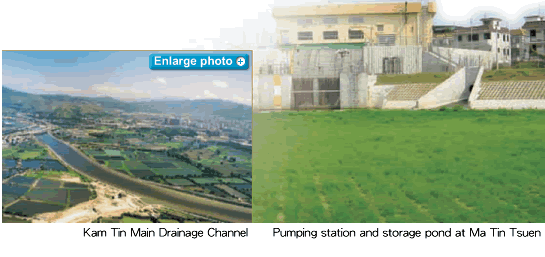
Flood prevention projects in the NT can broadly be classified into
two main types, namely drainage channels to collect and convey floodwater
to the sea and village flood pumping schemes to protect villages in
lowlying areas.
With the completion of drainage channels in recent years, the flooding
situation in the NT has been significantly improved, particularly
in Lo Wu, Ho Sheung Heung, Yin Kong and Tin Ping Shan in the Northern
NT and Tin Shui Wai, Yuen Long and Kam Tin in the Northwestern NT.
In the past, floodplains in the NT were often susceptible to flooding
to 1 to 1.5 m depth as overflow took place along the old river sections
which were narrow and sinuous. Nowadays, tens of thousands of people
in these flood prone areas have been relieved of flooding risks.
As regards low-lying villages in the flood plain areas, we have already
completed 23 village flood pumping schemes to remove the flood risks
at 30 low-lying villages. Over 220 hectares of low-lying villages
areas accommodating a population of 30,000 people are now being protected.
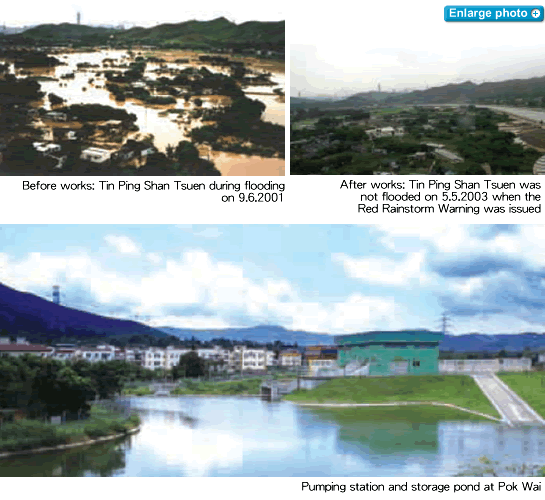
In the Northern NT, the Stage 3 works of the Shenzhen River Regulation
Project and the Rehabilitation of River Ganges are in good progress.
With the completion of these two drainage improvement projects, the
flooding situation at Lo Shue Ling, the last major flooding black
spot in the Northern NT, will be significantly improved.
In the Northwestern NT, construction works of the Ngau Tam Mei Main
Drainage Channel, Yuen Long Bypass Floodway and San Tin Eastern Main
Drainage Channel, as well as two village flood pumping schemes at
Wang Chau and Mai Po Lo Wai/Mai Po San Tsuen are progressing well.
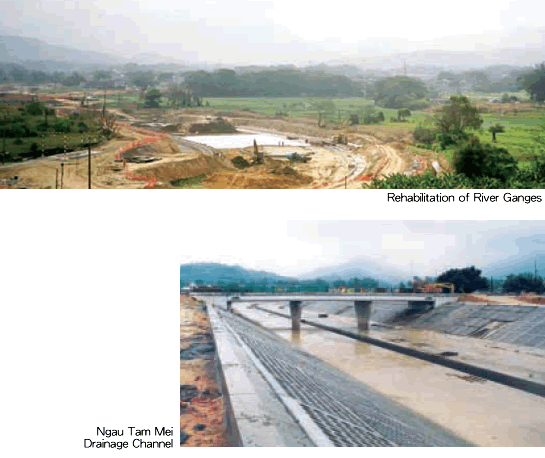
| Flood Prevention
in the Urban Areas |
|
Flood prevention projects in the urban areas mainly include improvements
of the flow capacity of the stormwater drainage networks in order
that stormwater would be collected and conveyed efficiently.
Under some special circumstances, innovative methods such as flood
storage, flood pumping or flow diversion are used to minimize the
extent of works that may cause disturbances to traffic or conflict
with underground utilities.
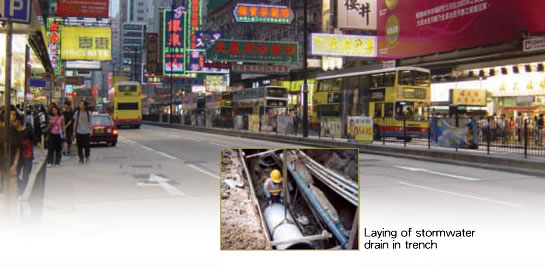
In West Kowloon, works under Stage 1 of the West Kowloon Drainage
Improvement Project were completed in June 2003. About 10 km of stormwater
drains were constructed in Yau Ma Tei, Mong Kok, Kowloon Tong, Sham
Shui Po and Lai Chi Kok. Works under Stages 2 and 3 are in good progress.
The most critical parts of the works are scheduled for completion
in 2004, which include an underground flood storage tank in Tai Hang
Tung and a stormwater diversion tunnel from Kowloon Tong to Kai Tak
Nullah. Construction of 35 km of stormwater drains in Tsim Sha Tsui,
Yau Ma Tei, Mong Kok, Sham Shui Po, Cheung Sha Wan, Lai Chi Kok and
Kowloon Tong will be completed progressively by 2007. Plan is also
in hand to implement a stormwater transfer scheme at Lai Chi Kok,
as this area is susceptible to flood risk due to surface runoff from
the hinterland and the potential overflow from the Kowloon group of
reservoirs.
For flood prone areas in the Northern Hong Kong Island, Tsuen Wan,
Kwai Chung and East Kowloon, drainage improvement projects costing
about $2.6 billion are being planned. In order to minimize the disturbance
to the local residents and road traffic due to trench excavation,
stormwater drainage tunnels will be constructed to divert stormwater
away so as to reduce the loading on the existing drainage systems
which are of insufficient capacity.
| Reduce Flooding Black
Spots |
|
Since 1994, DSD has identified more than a hundred flooding black
spots. All of the black spots are under close surveillance and improvement
measures have been taken to eradicate the flood risk. Last year, we
have successfully removed 9 flooding black spots.
| Yuen
Long Bypass Floodway |
|
Serious flooding has occurred in and
around Yuen Long Town over the past 10 years. Studies confirmed that
the existing Yuen Long Nullah drainage system is inadequate to meet
the current flood protection standard of passing a 200-year return
period storm event within the banks. This is mainly due to rapid growth
of Yuen Long Town over the last 20 years that has reduced the flood
storage capacity of the original flood plain and also increased the
volume of surface runoff. This, together with the fact that most of
Yuen Long Town is at a relatively low terrain and the existing nullahs
were designed to a much lower standards than the current ones were
also the major causes of flooding.
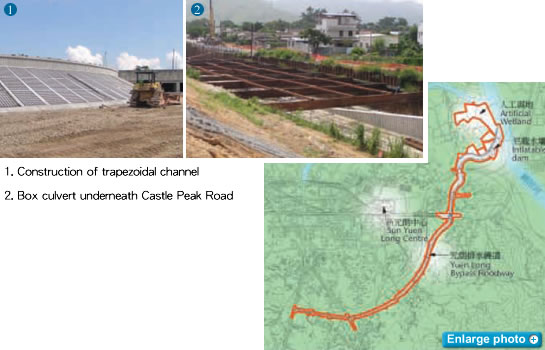
Construction of the Yuen Long Bypass Floodway (YLBF) is the most costeffective
option for improving the drainage system in Yuen Long Town. The YLBF
is designed to divert 15% of the flows from the Yuen Long Main Nullah
and all the surface runoff from the catchment to the south of the
channel into Kam Tin River. Upon completion, the YLBF will reduce
the flood risk in Yuen Long Town and provide the necessary additional
capacity to the existing nullahs so as to ensure the further development
of Yuen Long Town.
| Flooding
Relief to Ta Kwu Ling Areas |
|
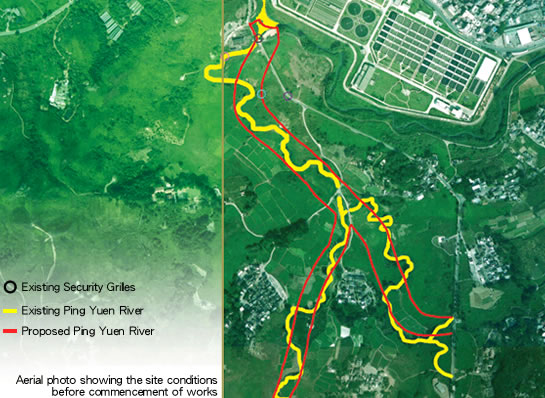
Due to the low-lying topography of Chow Tin Tsuen, Lei Uk, Fung Wong
Wu and the insufficient flowing capacity of Ping Yuen River and the
immediate downstream section of Shenzhen River, flooding frequently
occurred in the Ta Kwu Ling area during heavy rainstorms over the
years.
To tackle the flooding problem, river training works for Ping Yuen
River commenced in May 2003. The works are due to complete in 2006,
together with the regulation works for Shenzhen River Stage III, to
relieve the flooding problem in the area.
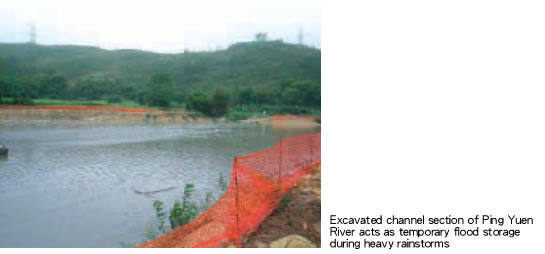
Meanwhile, two important interim flooding relief measures are being
implemented before the full completion of the works. Firstly, full
excavation to the designed width and depth of the proposed channels,
except at two locations intersecting with existing roads, was completed
before the rainy season in 2004. The partially completed channel sections
will be used as flood storage ponds in case of heavy rainstorms. In
addition, the existing border security grilles at the river mouth
of Ping Yuen River near Lin Ma Hang Road have been modified such that
they could be opened to allow faster flow of floodwater during heavy
rainstorms.
Whilst these measures might not be able to fully protect the areas
from flooding, it however was found that all the floodwater flows
had been successfully retained within banks of the proposed channels
during the six rainstorms with amber/black rainstorm warnings in April,
May and June of 2004.
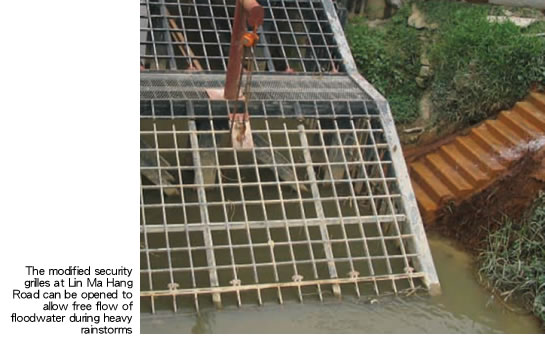
| Tai Hang
Tung Storage Scheme |
|
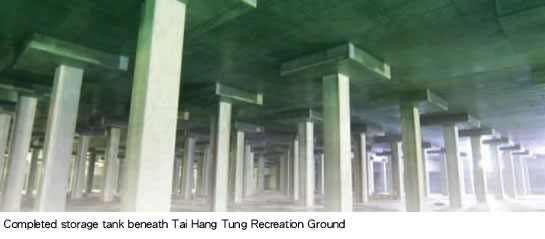
The Tai Hang Tung Storage Scheme (THTSS)
forms an integral part of an overall West Kowloon drainage improvement
scheme to solve the flooding problem in Mong Kok by 2004. It is the
first large-scale underground floodwater storage tank built in Hong
Kong with a capacity of 100,000 m3.
The THTSS involves deep excavation to a depth of over 10 m within
an extremely tight working space at the Tai Hang Tung Recreation Ground.
Two-stage construction is therefore adopted to cope with the space
constraints and to minimise disturbance to the park users. Additional
working space is created by early completion of storage tank roof
slab and using the roof slab as an access and storage area. Extensive
grouting and recharging wells has been used to control settlement
arising from the deep excavation to a tolerable limit. The THTSS has
been put into partial operation by allowing floodwater flowing into
the partially completed tank during heavy rains since end March 2004.
Even though the construction was affected by the stormwater inflow,
it is very pleased that the tank has been partially functioning to
protect the Mong Kok area from flooding in the wet season of 2004.
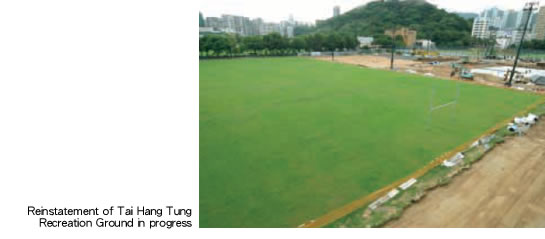
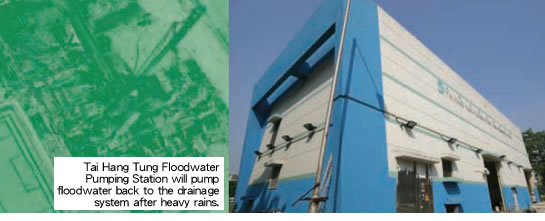
The completion of the THTSS in the summer of 2004 marked an important
milestone in the Government's efforts in solving the flooding
problem in Mong Kok.
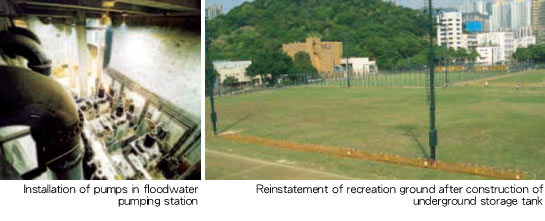
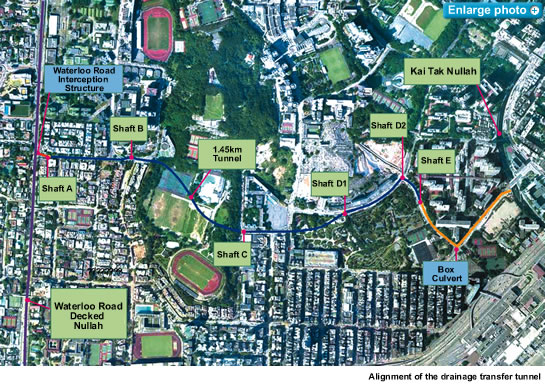
Kai Tak Transfer Scheme (KTTS) being the first drainage tunnel system
built in Hong Kong forms an integral part of the West Kowloon Drainage
Improvement works for solving the flooding problem in Mong Kok. Upon
completion, KTTS will intercept and transfer about 60% of upstream
stormwater flow in an existing decked nullah underneath Waterloo Road,
Kowloon Tong, through a 1.42 km long drainage tunnel of 4.4m internal
diameter to Kai Tak Nullah at San Po Kong. The target flow transfer
through the drainage tunnel is 40m3/s under a 50-year return period
rainfall. The works also include construction of a 40m long interception
structure, 500m box culverts and six access shafts to facilitate tunnel
construction, operation and maintenance.
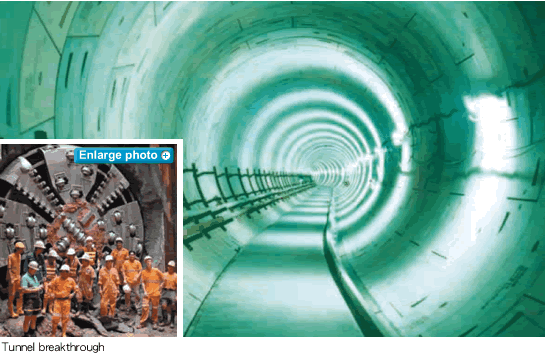
A 5.17m diameter mixshield tunnel boring machine (TBM) started tunnel
excavation in September 2002 for the first drive between Shaft B at
Hereford Road and Shaft D2 at Tung Tau Tsuen Road. The second drive
is between Shaft D2 and Shaft E at Tung Tsing Road. Following re-launch
at Shaft B and driving 280m in the opposite direction, the TBM successfully
broke into Shaft A off junction of Waterloo Road and Hereford Road
in February 2004, signifying a major milestone of completing the
tunnel excavation works. The TBM drove through highly variable grounds
including completely decomposed granite (CDG), full face slightly
decomposed granite, alluvium and CDG with corestones at depths between
4m and 30m. Low cover, close proximity to sensitive buildings and
utilities, turning the TBM through 90° at Shaft D2 and re-launching
the machine at Shaft B are the major challenges to the project team.
By adopting the drainage tunnel transfer concept, the KTTS has greatly
reduced the open excavation in the highly congested urban areas of
Mong Kok. The Scheme was built safely in an environmentally friendly
manner with minimal disruption and disturbance to the public. The
completion of the Scheme in the summer of 2004 marked an important
milestone in the Government's efforts in solving the flooding
problem in Mong Kok. |
 |

